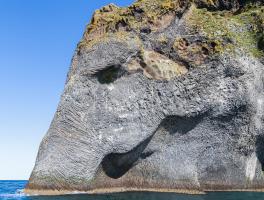 On the 21st of January, 1973, the island of Heimaey, four nautical miles off the south coast of Iceland, began to tremble. On the 23rd, a large fissure opened up on the eastern side of the island, barely a kilometer away from the center of the town of Heimaey. Volcanic ash began to fall over most of the island and lava began to flow toward the town.
On the 21st of January, 1973, the island of Heimaey, four nautical miles off the south coast of Iceland, began to tremble. On the 23rd, a large fissure opened up on the eastern side of the island, barely a kilometer away from the center of the town of Heimaey. Volcanic ash began to fall over most of the island and lava began to flow toward the town.
Fortunately, the fishing fleet was in the harbor and most of the population left successfully by the island by boat. Remarkably, within 6 hours close to 5,300 islanders were evacuated to the mainland. A small contingent stayed behind to perform essential duties and monitor the situation. Only one person was killed by the eruption.
The eruption continued and by early February, a lava stream was threatening to close off the mouth of the harbor. The flow was slowed and diverted by pumping cold salt water on the approaching lava. After initial success, the pumping was increased and continued through March. The harbor entrance was narrowed but not closed off. Ultimately, the new volcanic rock provided an extended breakwater for the harbor.
The eruption continued for five months. Lava and ash destroyed around 400 homes. A 660′ high cinder cone rose from the eruption site. The new mountain was named Eldfell, or “Mountain of Fire” in Icelandic.
OK, but what does this have to do with the first elephant born in Iceland? At some point during the eruption, new lava flows of basaltic rock created a rock formation that looks remarkably like an elephant. It is referred to, not surprisingly, as Elephant Rock.
The zoo in Iceland’s capital of Reykjavik does not have an elephant. The only elephant in Iceland is on Heimaey, born with the Mountain of Fire in 1973.
